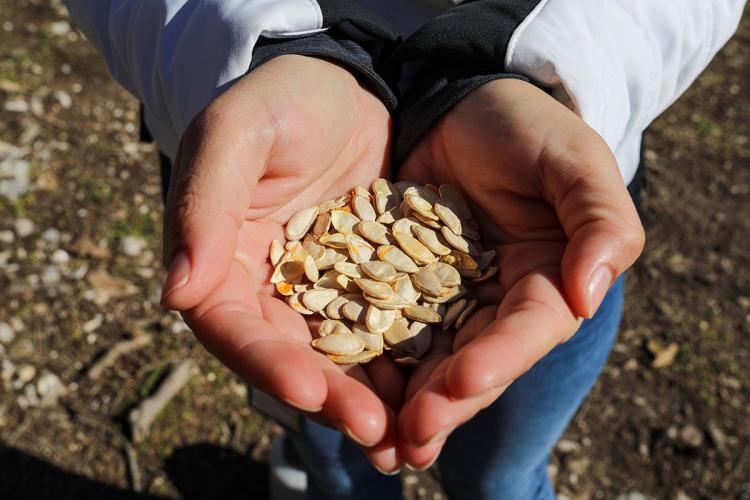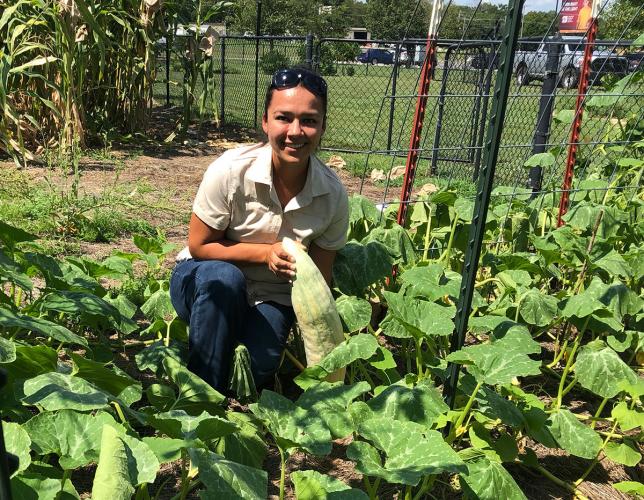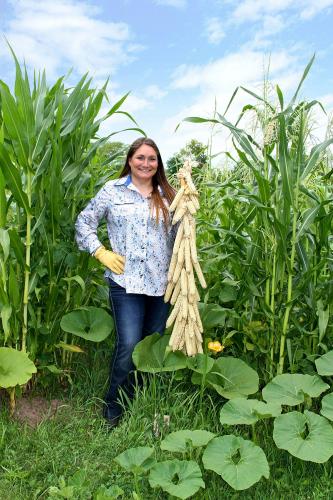On a few acres of land near Talequah, Oklahoma, Feather Smith has spent nearly a decade reuniting the seeds of her Cherokee ancestors with her people. “Agriculture is ingrained in our culture, religion and ceremonies,” said Smith, an ethnobiologist for the Cherokee Nation. Heirloom varieties of corn, beans, squash and pumpkin—crops that have legacies dating back to before contact with Europeans—are now grown here on tribal land, thousands of miles from where this Cherokee community first lived in the East.
Smith is among many Native cultivators across the Americas who are preserving seeds of plants that have not only nourished their tribal members’ bodies but also been an integral part of their culture, often being expressed through art, songs and dances. For some, all of this is done in a backyard garden. Others such as Smith and Mohawk farmer Stephen McComber are working on small farms that provide seeds to fellow tribal members.
“Seeds are life,” said McComber. “Without seeds, we would not exist as a people. We see then as a gift from our creator.”
McComber has been gardening for 50 years and has amassed a large collection of seeds. In the process, he has also created a network of other seed savers and growers from tribal nations in the United States and Canada who meet annually to swap seeds.
Traditionally, Indigenous farmers saved seeds from a portion of each year’s harvest for planting in subsequent years. They carefully selected seeds that produced better yields, were of different colors or could survive droughts or floods. Neighboring tribes exchanged seeds, and over time, these crops spread across the continent. For example, corn was first cultivated in Mexico, but by the time Europeans arrived, it had been traded all the way up to New England. The result was a range of crop varieties that were locally adapted to regions across the Americas.
“We view our seeds and plants like our children,” said Aaron Lowden, an Acoma coordinator at the Indigenous Seed Keepers Network. “We baby them and nurture them along during each stage of development.”
Yet colonization of Native Americans sometimes led these children far from home. Museums, laboratories and corporations that took or accepted donated seeds from Native cultivators viewed them as objects. Large collections of seeds reside in the United States Department of Agriculture’s (USDA) National Plant Germplasm System and similar collections elsewhere. Seeds from all over the world have been collected in the Global Seed Vault, the “doomsday” cold storage locker for the world’s plant resources, frozen deep in a man-made cave on the Norwegian island of Svalbard, 780 miles north of the Arctic Circle.
Tribes are concerned about their heirloom varieties from such seed banks being distributed to nontribal members. Whereas seeds at Svalbard can only be accessed by those who donated them, “most of the seeds in the USDA’s National Plant Germplasm System are available to those engaged in professional scientific research, agricultural production and education,” said Heather Dawn Thompson, a Cheyenne River Sioux researcher who serves as director of the USDA Office of Tribal Relations. Thompson said the USDA does have more protective seed storage options available for governments and is considering the needs of tribal nations. The department also has provided seed-cleaning machinery at a half dozen sites around the country to encourage tribes to maintain their own collections. Rather than locking up seeds in cold storage, these Native seed savers grow them and distribute them to others to do the same—a living form of preservation.
Hybrid commercial seeds may have a higher yield or be more disease resistant, but those advantages don’t outweigh the cultural value of heirloom seeds to Indigenous people. Like other seed savers, Smith plants only a few crops each year, limited in part by available acreage but also to preserve the genetic identity of each variety, she said. Planting two varieties of corn close together, for example, might lead to accidental hybridization. So each year, the Cherokee Nation’s farm raises just one of 11 different varieties of corn, four varieties of beans, one of squash and one of pumpkin. Others, such as McComber who has a small plot outside Montreal, avoid accidental hybridization by growing varieties far enough apart that they cannot cross-pollinate. On the Oneida Reservation near Green Bay, Wisconsin, Oneida farmers Becky and Steve Webster start their corn early in the year under plastic tunnels to separate them from other plants that flower later.
At Tesuque Pueblo in New Mexico, Mohawk and Anishinaabe cultivator Clayton Brascoupé has a rigorous way of keeping his seeds safe. “First, we clean them to eliminate chaff. Sometimes we freeze them for 48 hours to kill any insects or eggs. Then we store them in a special underground building cooled by a solar-powered fan, where they can remain cool and dry.”
Brascoupé shares both seeds and information. Since 1994, through the Traditional Native American Farmers Association, he has taught seed-saving to other Indigenous groups in the United States, Canada and Central America. “The Maya in Belize saw low germination rates in [commercial] hybrids as a problem,” said Brascoupé. So he worked with them to identify locally adapted varieties of corn that had better flavor and nutrition and that produced seeds they could save, share and replant in subsequent years.
Ultimately, said Brascoupé, the seed-saving movement is about food sovereignty. “You—not others—have control over what you’re growing and what you’re eating,” he said.
In addition to keeping existing heirloom species pure, another significant goal of seed savers is rediscovering older varieties that have nearly disappeared. These seeds are inheritors of thousands of years of adaptation to local climate and geography. O’odham squash and tepary beans, for instance, grow best in Southwest deserts because they require less water than other varieties.
Sometimes seeds stashed away in Mason jars turn up in old houses, barns or in museums or scientific collections. “Someone, somewhere has those seeds,” said Lowden. His uncle once found a little container of Northside squash (also known as “banana squash”), which Lowden grew until they had enough seeds to share with others. Youth from Lowden’s learning program retrieve seeds, grow their plants and then give packets of new seeds to families whose ancestors once grew them. “It was like getting a piece of their relative back,” he said. “Now those seeds are recirculating on the Acoma Pueblo again.”
“Indigenous seeds started to find me,” said Ho Chunk farmer Jessika Greendeer. Elders gave her seeds who did not have family members interested in growing them. Eventually, she produced 20 varieties of flowers, 30 varieties of corn as well as beans, squash, potatoes, tomatoes and more. “It’s not how many seeds I can keep for myself, but how many other hands I can get those seeds into,” she said.
The most satisfying part of her work, said Greendeer, is liberating seeds from museums and other institutions, growing them and reuniting them with their original names and a Native food system. She said, “Having a first taste of the food that seed produced not only nourishes me but makes me feel that my spirit is being fed.”



